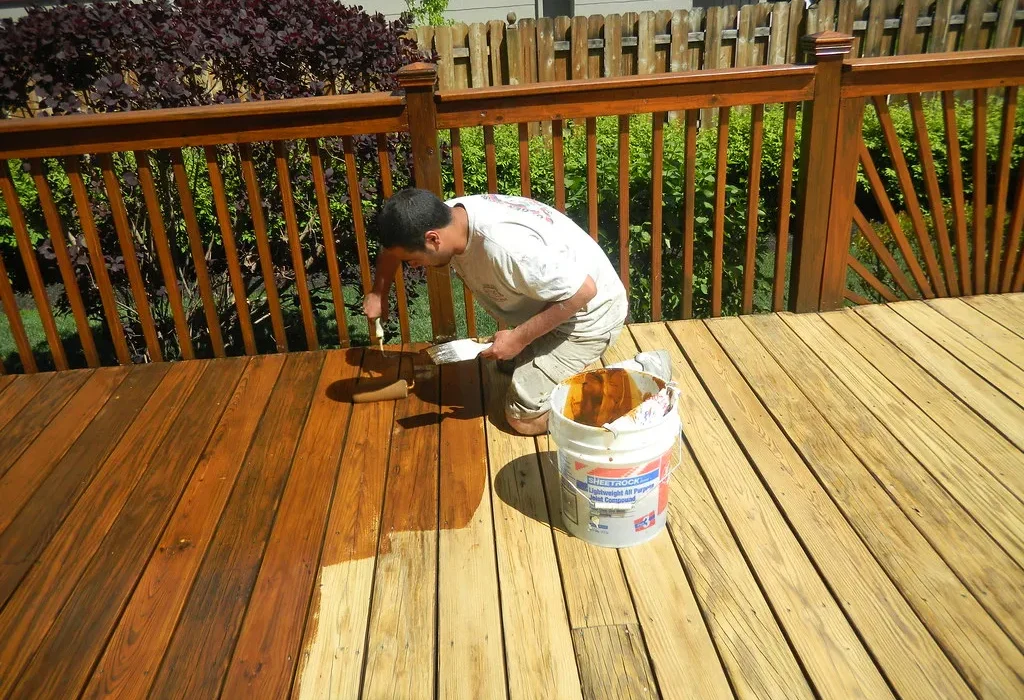Image Credit: flickr.com
Understanding Elastomeric Deck Coating
When it comes to protecting and beautifying your outdoor spaces, elastomeric deck coating emerges as a game-changer. This type of coating is specifically designed to provide a durable and flexible finish that can withstand the harsh elements and foot traffic. It not only enhances the visual appeal of your deck but also prolongs its lifespan, saving you time and money on repairs and replacements in the long run.
Why Elastomeric Deck Coating is Essential for Outdoor Spaces
Outdoor spaces, such as decks, are constantly exposed to various weather conditions, including rain, snow, UV rays, and temperature fluctuations. Without proper protection, the wood or concrete material used for decking can deteriorate quickly, leading to cracks, rotting, and structural damage.
This is where elastomeric deck coating becomes essential. Its elastomeric properties allow it to expand and contract with the substrate, accommodating movement caused by temperature changes. This flexibility prevents cracking and delamination, ensuring a waterproof barrier that keeps moisture out. By creating a protective layer, elastomeric deck coating shields your deck from UV damage, abrasion, and water infiltration, significantly extending its lifespan.
The Science Behind Elastomeric Deck Coating: How it Works
Elastomeric deck coating is formulated using advanced polymer technology. The main ingredient is an elastomeric resin, which provides the coating with its elasticity and durability. This resin is combined with other additives, such as fillers, pigments, and binders, to enhance the coating’s performance and application properties.
When applied to a properly prepared deck surface, the elastomeric deck coating forms a seamless and continuous membrane. As the coating dries, the elastomeric polymers crosslink, creating a flexible and tough film. This film can stretch and move without cracking or peeling, even under extreme weather conditions, ensuring long-term protection for your deck.
Exploring the Benefits of Elastomeric Deck Coating
Elastomeric deck coating offers a plethora of benefits that make it an ideal choice for outdoor spaces:
- Waterproofing: Elastomeric deck coating forms a waterproof barrier that prevents water from seeping into the underlying structure, protecting your deck from water damage and decay.
- Flexibility: The elastic nature of the coating allows it to expand and contract with the substrate, accommodating movement and preventing cracking and delamination.
- UV Resistance: Elastomeric deck coating contains UV inhibitors that shield your deck from the damaging effects of the sun’s rays, such as fading, discoloration, and deterioration.
- Durability: The tough and resilient nature of the coating ensures long-lasting performance, withstanding foot traffic, impacts, and wear and tear.
- Slip Resistance: Many elastomeric deck coatings have additives that improve traction, reducing the risk of slips and falls, especially when the deck is wet.
- Easy Maintenance: Elastomeric deck coating is relatively low maintenance, requiring periodic cleaning and simple touch-ups to keep it looking its best.
Choosing the Right Elastomeric Deck Coating
Choosing the right elastomeric deck coating is crucial to ensure optimal protection and performance. Consider the following factors when selecting a coating:
Factors to Consider When Selecting Elastomeric Deck Coating
- Substrate Type: Determine whether your deck is made of wood or concrete, as different coatings are formulated for each substrate. The coating should be compatible with the deck material to ensure proper adhesion and performance.
- Climate: Consider the climate in your area. If you experience extreme temperature fluctuations or high levels of humidity, choose a coating that can withstand these conditions without compromising its properties.
- Desired Finish: Decide on the finish you want for your deck. Elastomeric deck coatings come in various colors and textures, allowing you to customize the appearance of your outdoor space.
- Warranty: Look for coatings that come with a warranty. A warranty indicates the manufacturer’s confidence in the product’s performance, giving you peace of mind and assurance of quality Rubber Extrusions.
Comparing Different Types of Elastomeric Deck Coating
There are different types of elastomeric deck coatings available, each with its specific characteristics and application methods. The choice depends on your deck’s requirements and your personal preferences. Some common types include:
- Water-Based Coatings: These coatings are easy to work with and have low VOC (volatile organic compounds) levels, making them environmentally friendly. They dry quickly and offer good durability and flexibility.
- Solvent-Based Coatings: Solvent-based coatings have higher VOC levels and longer drying times, but they provide excellent water repellency and enhanced durability. They are suitable for more extreme climates.
- Textured Coatings: Textured elastomeric coatings provide a non-slip surface, which makes them ideal for decks with high traffic areas or pool decks that must withstand rain.
- Tintable Coatings: Tintable elastomeric coatings offer the advantage of color customization. You may create a unified and visually appealing outdoor space by tinting them to fit your preferred color scheme.
How to Ensure Proper Adhesion and Durability of the Coating
For the elastomeric deck coating to perform at its best, proper surface preparation is crucial. Follow these steps to ensure proper adhesion and durability:
- Clean the Deck: Remove any dirt, debris, and stains from the deck surface. To remove any dirt, use a scrub brush, light detergent, and deck cleaning. After giving the deck a thorough rinse, let it dry entirely.
- Repair Damaged Areas: Fill in any cracks, holes, or damaged areas in the deck using an appropriate filler or patching compound. Smooth the surface and allow it to dry according to the manufacturer’s instructions.
- Sand the Surface: If the deck has a rough or uneven surface, sand it to create a smooth and even base. This step ensures better adhesion and a uniform finish.
- Apply a Primer: Depending on the type of coating and the manufacturer’s instructions, apply a primer to promote adhesion. The primer lengthens the coating’s lifespan and aids in its adhesion to the deck surface.
- Apply the Coating: Follow the manufacturer’s instructions for applying the elastomeric deck coating. Use a roller or a brush, and ensure even coverage. Apply multiple coats if recommended, allowing sufficient drying time between each coat.
- Maintain the Coating: Regularly inspect and clean your coated deck to remove any dirt or debris. Make any necessary touch-ups or repairs promptly to prevent further damage.
Applying Elastomeric Deck Coating Like a Pro
Applying elastomeric deck coating may seem daunting at first, but with the right techniques, you can achieve professional-looking results:
Preparing Your Deck for the Coating Application
- Clear the Area: To make an area that is clear and easy to reach, remove all furniture, plants, and other items off the deck.
- Clean the Deck: Thoroughly clean the deck using a deck cleaner and scrub brush. Rinse off any cleaning residue and allow the deck to dry completely before proceeding.
- Repair Damaged Areas: Inspect the deck for any cracks, splinters, or damaged areas. Repair them using suitable fillers or patching compounds, and ensure the surface is smooth and free of any obstacles.
Mastering the Techniques of Applying Elastomeric Deck Coating
- Start with the Edges: Use a brush or a small roller to apply the coating to the edges and corners of the deck. This ensures proper coverage in hard-to-reach areas.
- Apply in Thin, Even Coats: When applying the coating to the main deck surface, use a roller or a sprayer for larger areas. Apply thin, even coats, working in small sections. Avoid over-applying the coating, as this can lead to pooling and uneven drying.
- Work with the Grain: If your deck has wood planks, apply the coating in the direction of the grain for a more natural and uniform finish.
Avoiding Common Mistakes During the Coating Application Process
It is important to avoid a few typical mistakes when applying elastomeric deck coating as they can lower the quality of the end product:
- Skipping Surface Preparation: Neglecting proper cleaning, repairs, and priming can lead to poor adhesion and premature coating failure.
- Over-applying the Coating: Applying the coating too thick can result in uneven drying and an unattractive finish. Follow the manufacturer’s recommendations for application thickness.
- Not Allowing Sufficient Drying Time: Rushing the drying time between coats or before exposing the deck to foot traffic can cause the coating to peel or become damaged.
- Ignoring Maintenance: Regular maintenance, such as cleaning and touch-ups, is essential to extend the lifespan of the coating. Ignoring upkeep might result in premature aging and reapplication requirements.
Maintaining and Extending the Lifespan of Elastomeric Deck Coating
Maintaining your elastomeric deck coating is key to preserving its appearance and performance. Follow these best practices to ensure longevity:
Best Practices for Maintaining Your Coated Deck
- Regular Cleaning: Remove dirt, debris, and stains from your deck regularly. Use a mild detergent, water, and a soft brush or broom to scrub away grime. Before using, give the deck a good rinse and let it air dry.
- Avoid Harsh Cleaners: Harsh chemicals, bleach, or abrasive cleaners can damage the coating and compromise its integrity. Stick to gentle cleaners specifically formulated for use on coated decks.
- Promptly Address Stains: Treat any spills or stains on the deck surface immediately to prevent them from seeping into the coating. Blot or gently scrub the affected area using a mild cleaner and water.
Tips for Repairing and Touching Up Your Elastomeric Deck Coating
Over time, your elastomeric deck coating may experience minor wear or damage. Here are some tips for repairing and touching up the coating:
- Clean the Area: Before making any repairs or touch-ups, clean the damaged area thoroughly to remove dirt, debris, and loose coating.
- Feather the Edges: To ensure a smooth transition between the touch-up coat and the original coating, feather the edges of the new coat.
- Allow Sufficient Drying Time: Before exposing the touch-up coat or repair to foot traffic or the outdoors, be sure it has had enough time to dry completely.
Preventative Measures to Extend the Longevity of the Coating
To increase the durability of your elastomeric deck coating, you can take proactive steps in addition to routine maintenance:
- Use Furniture Pads: Place furniture pads or coasters under the legs of your outdoor furniture to prevent scratches and indentations on the deck surface.
- Minimize Heavy Impacts: Avoid dropping heavy objects or dragging sharp tools across the deck, as these can damage the coating.
- Keep the Deck Clear: Regularly sweep away leaves, debris, and snow from your deck to prevent them from accumulating and trapping moisture.
- Apply a Sealant: Consider applying a clear sealant over the elastomeric deck coating to provide an extra layer of protection and further extend its lifespan.
With the essential guide to elastomeric deck coating, you now have the knowledge and insights to protect and beautify your outdoor spaces. By understanding the science behind elastomeric deck coating, choosing the right product, applying it correctly, and maintaining it diligently, you can ensure a long-lasting and visually appealing deck that will withstand the test of time.
Also Read: Modern Home Design Trends

